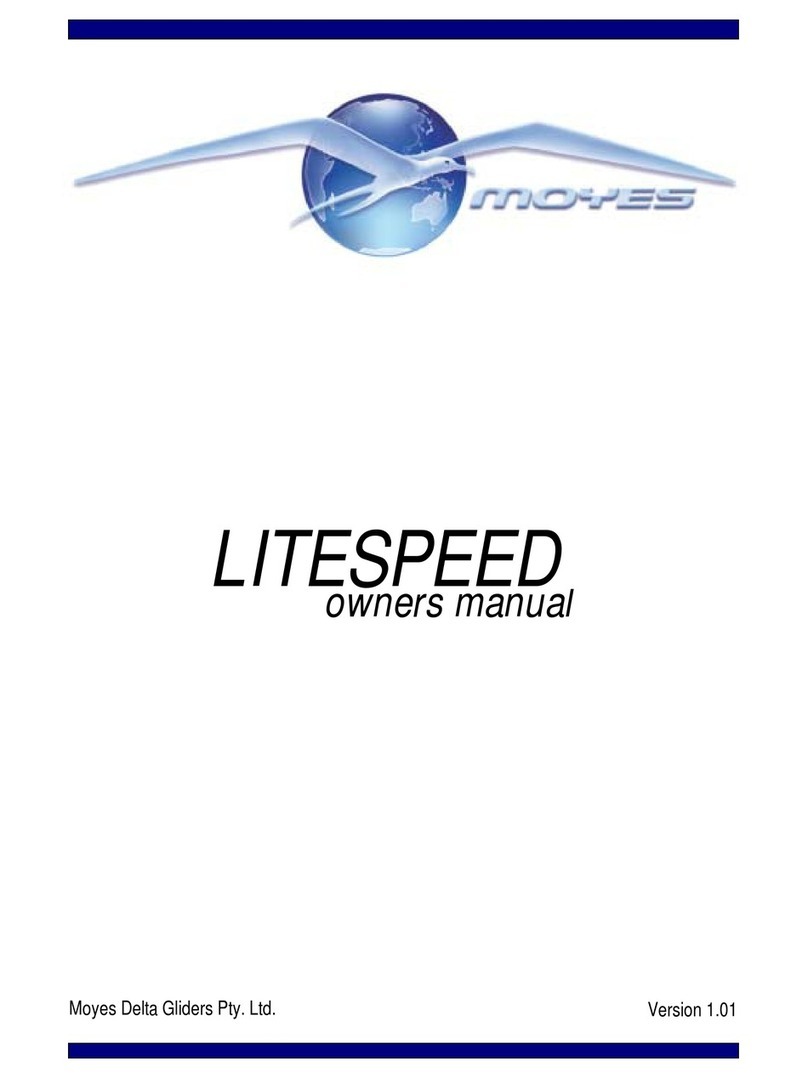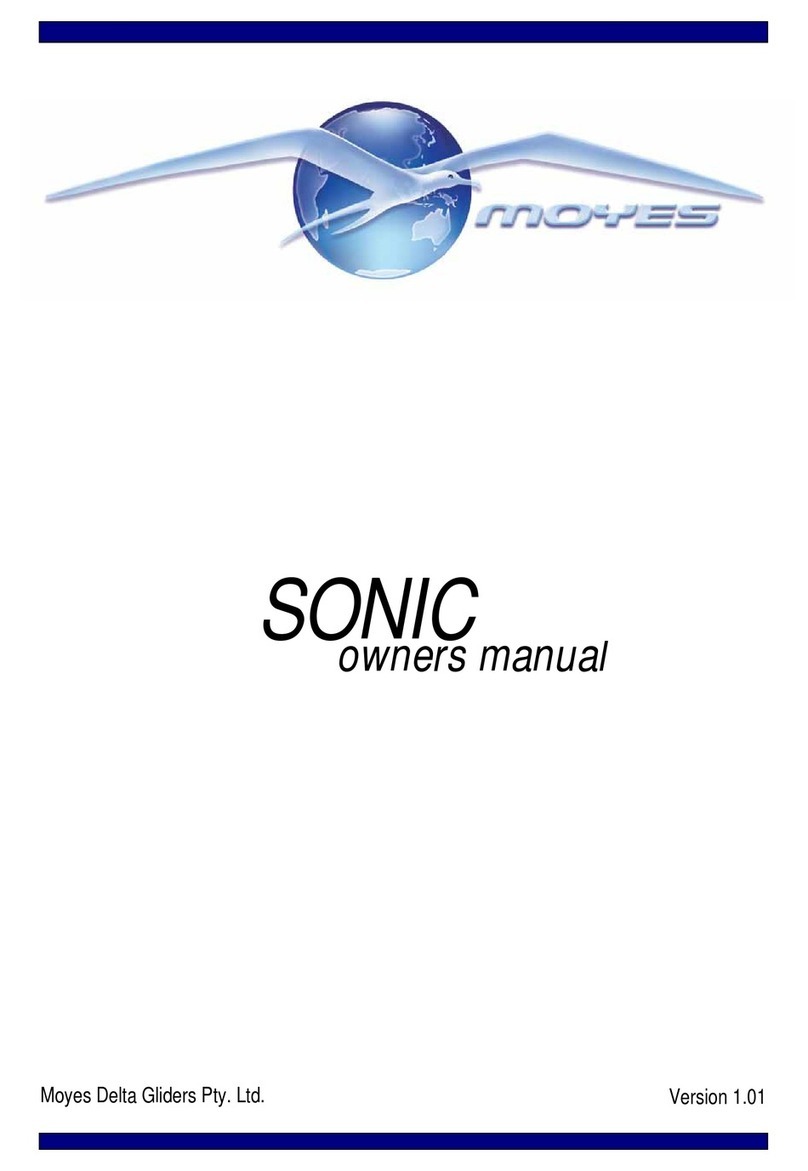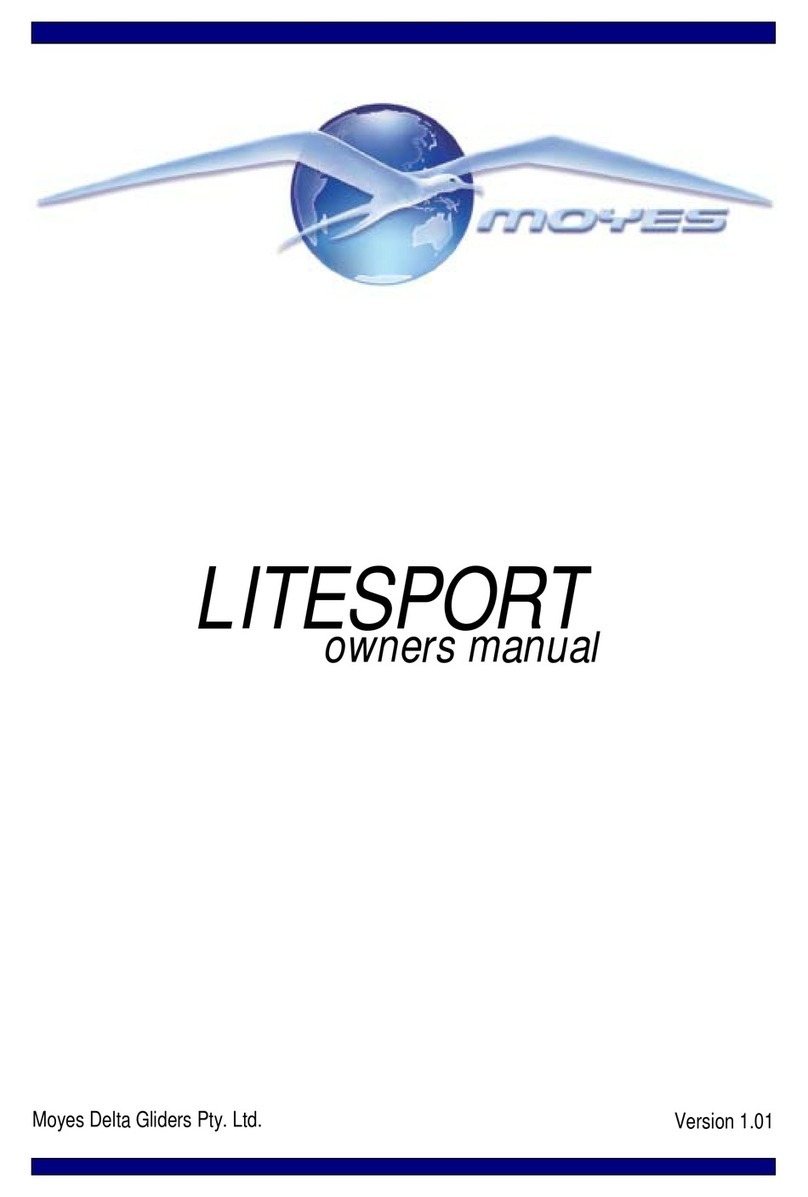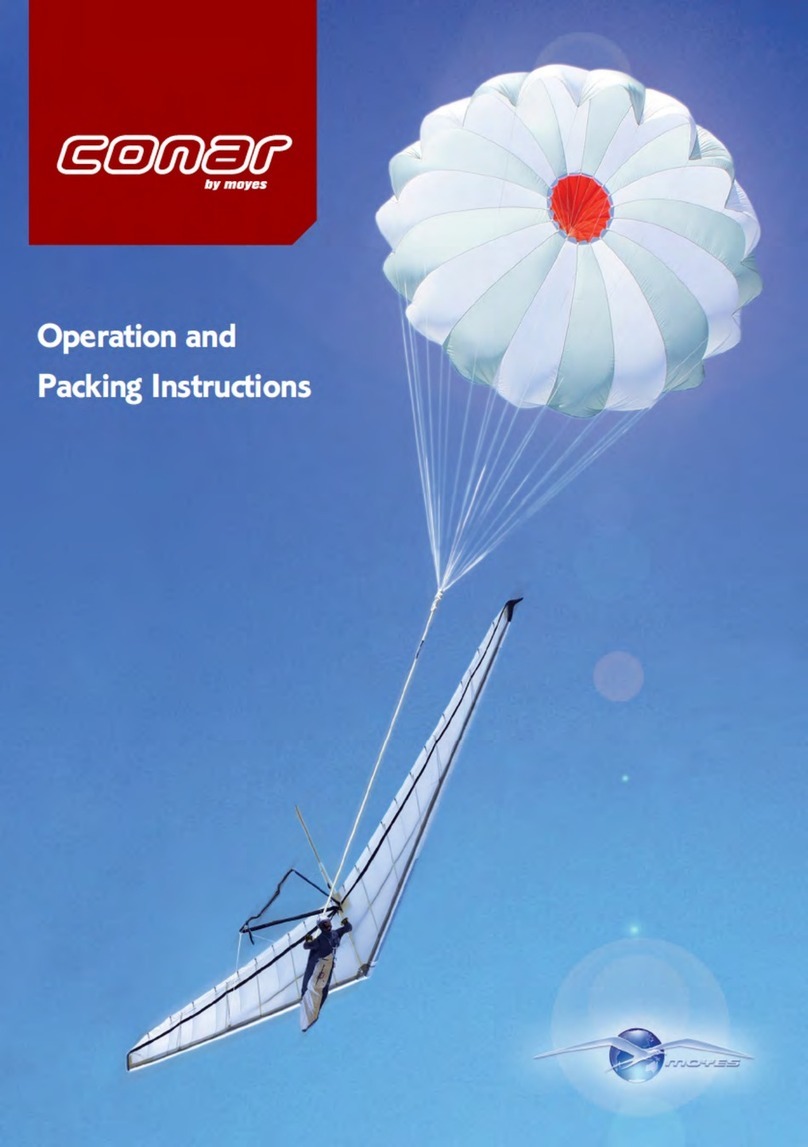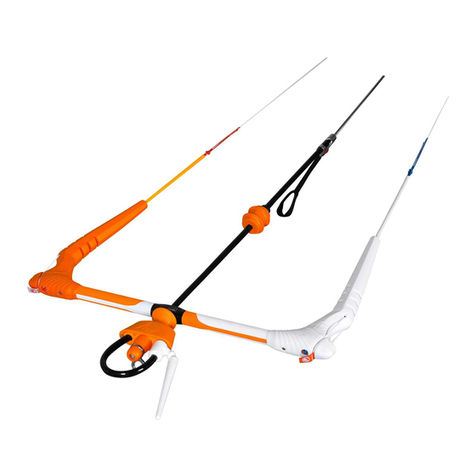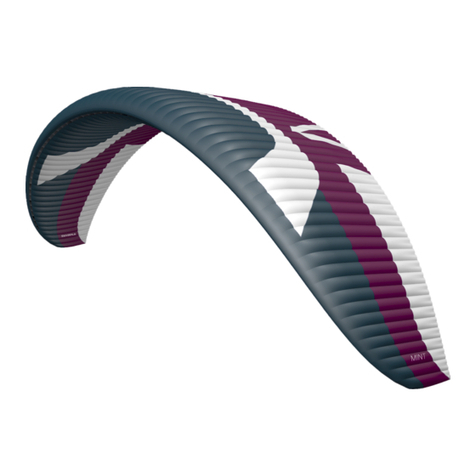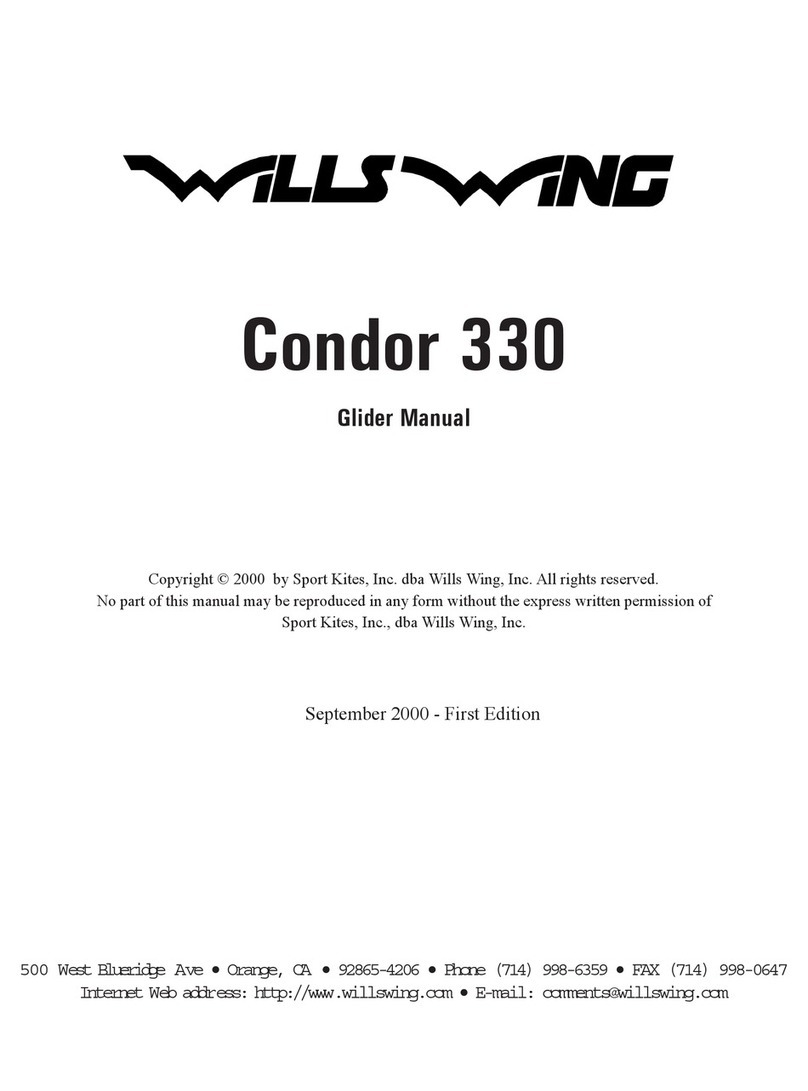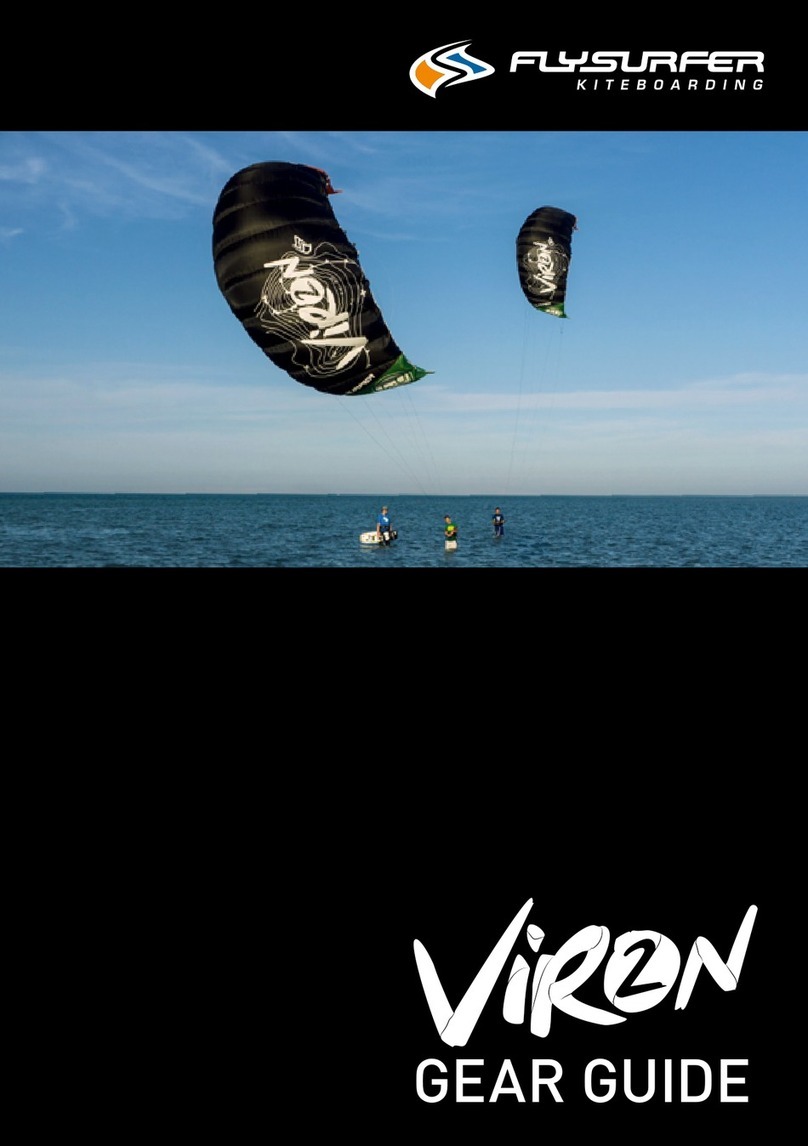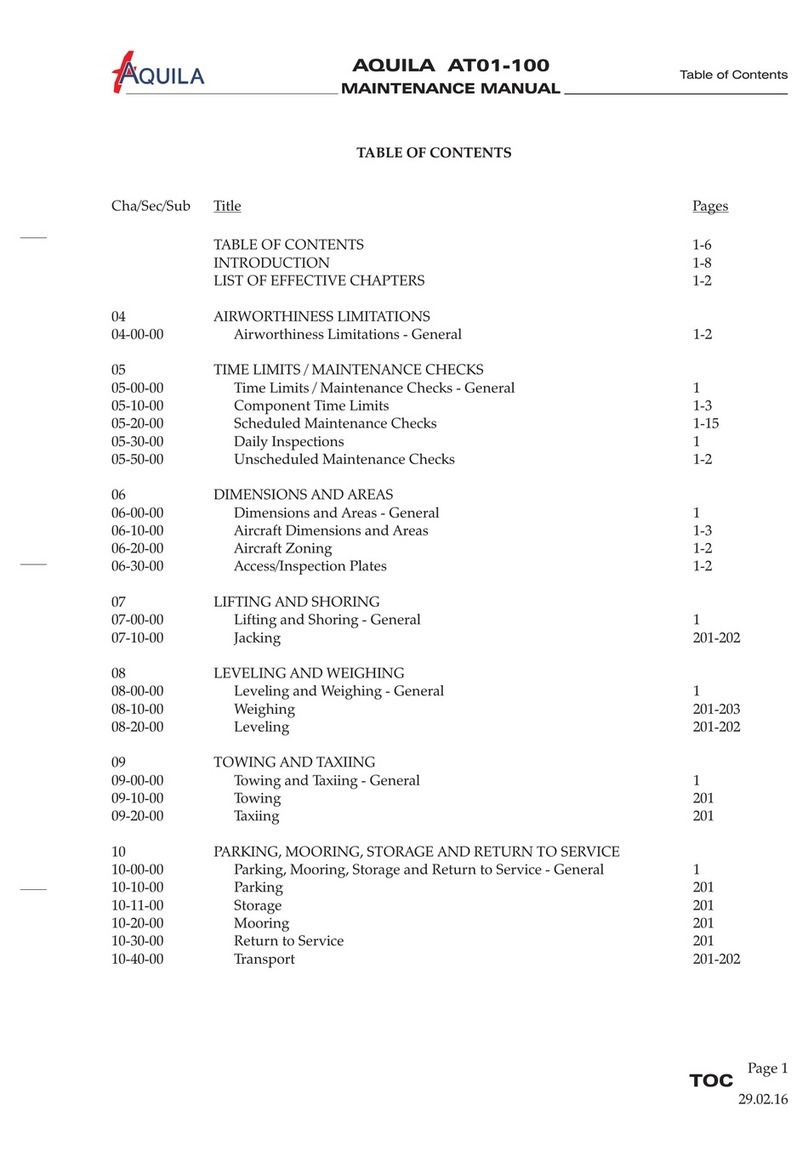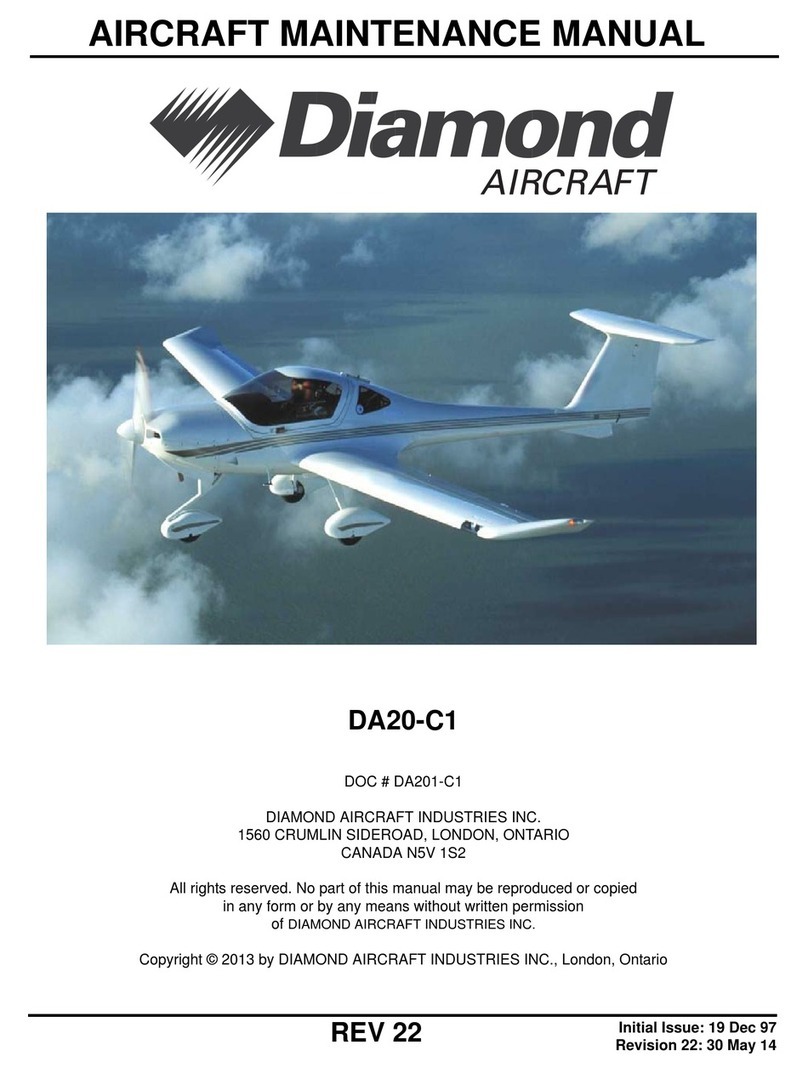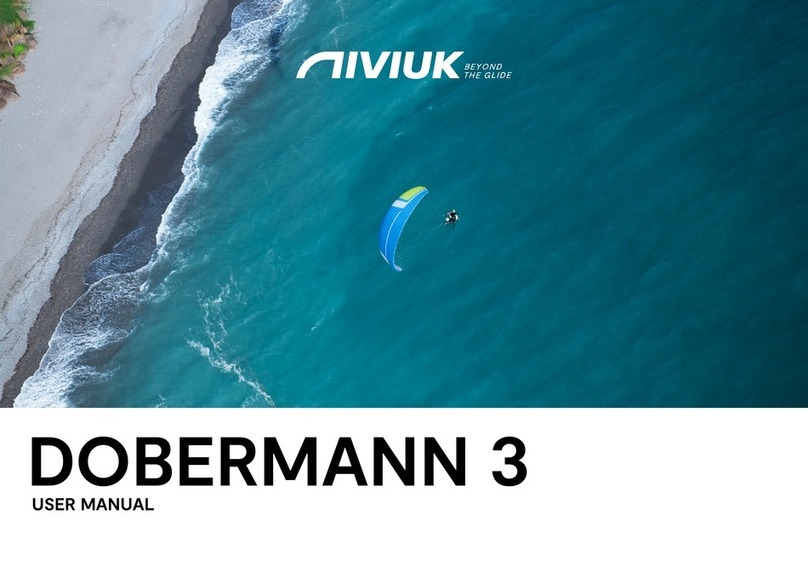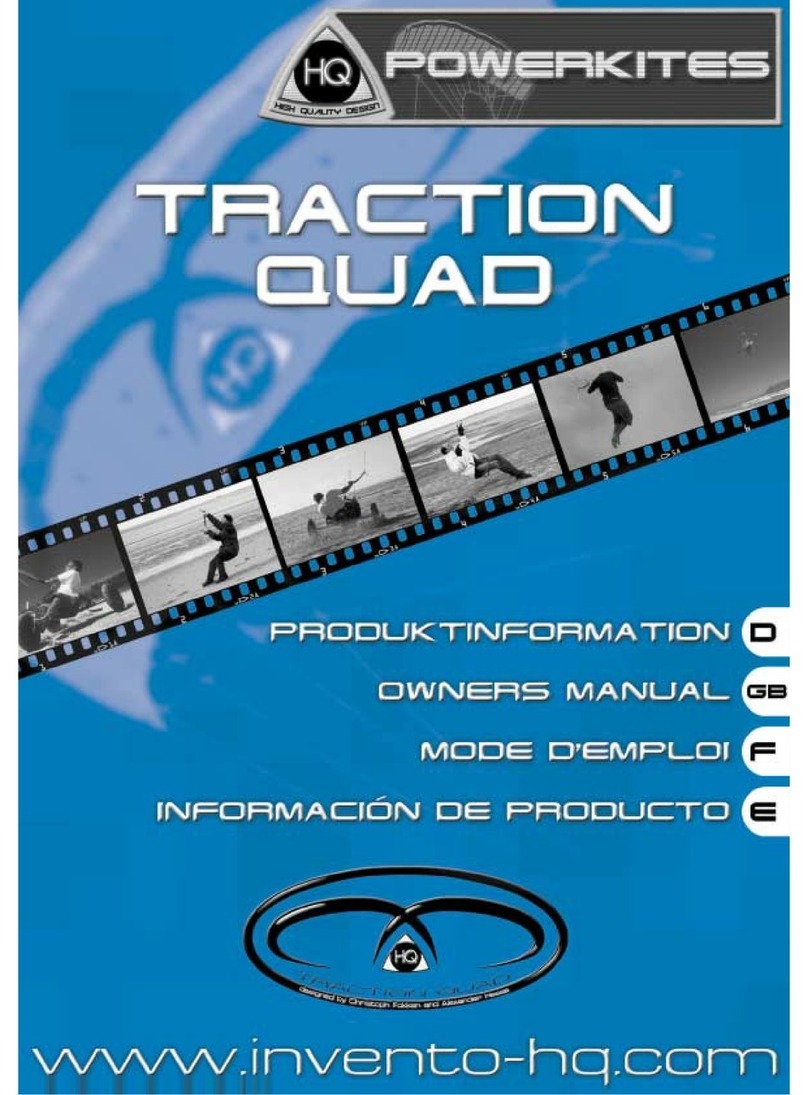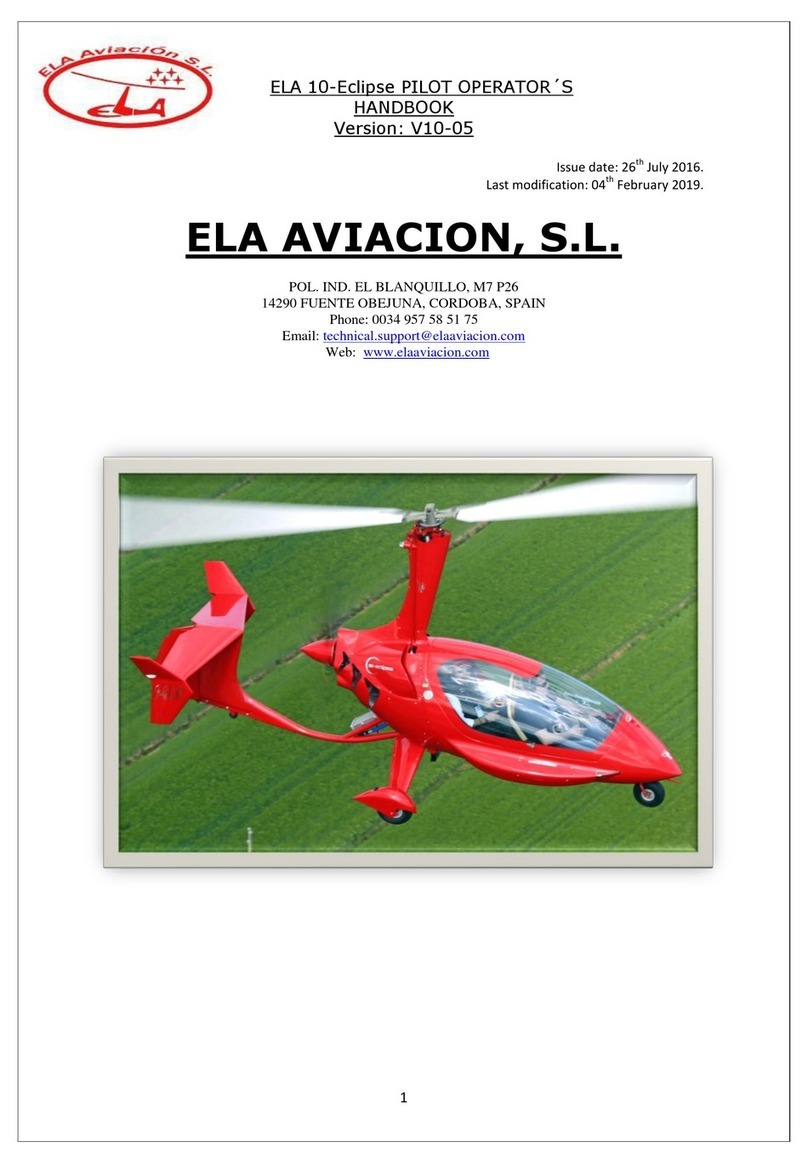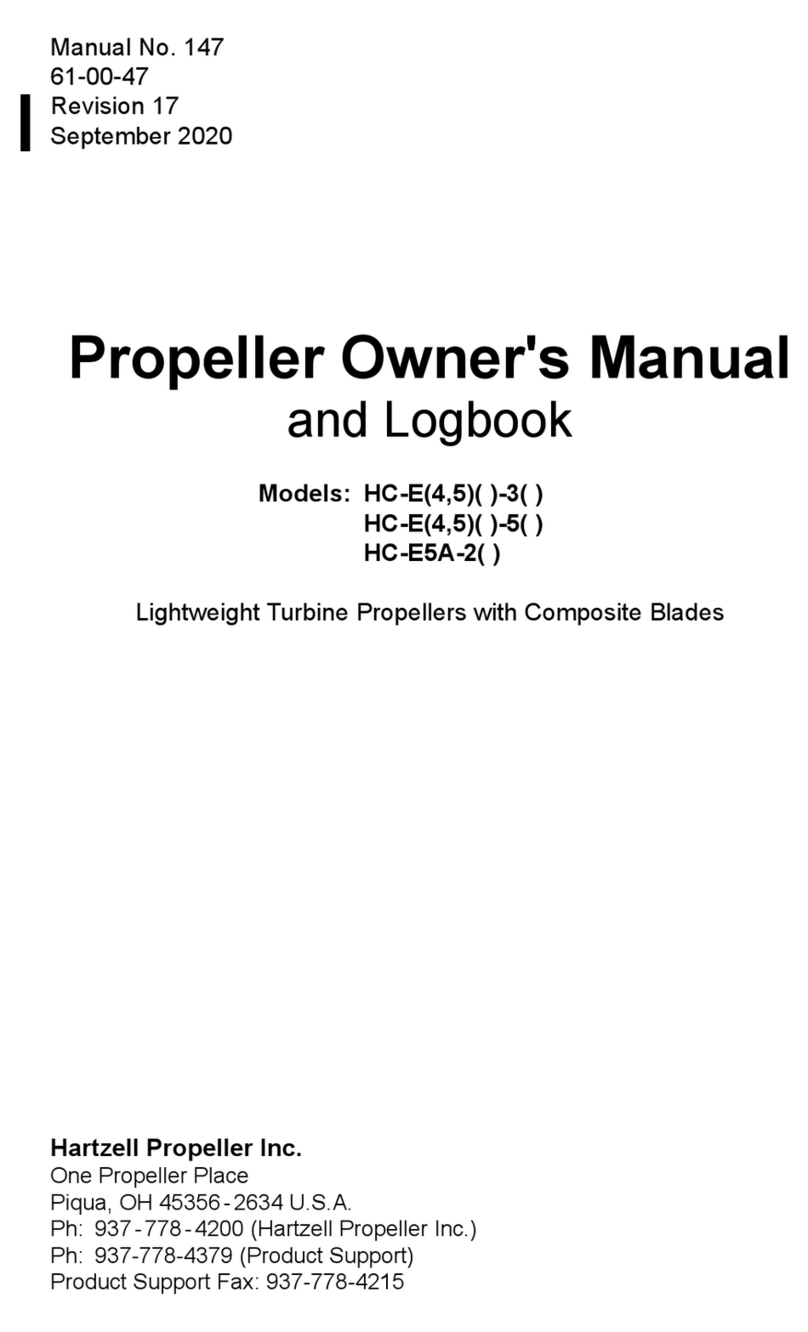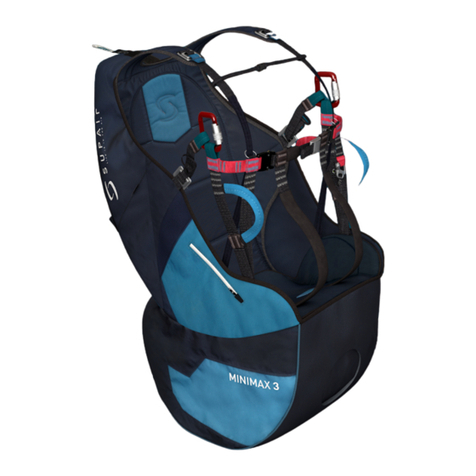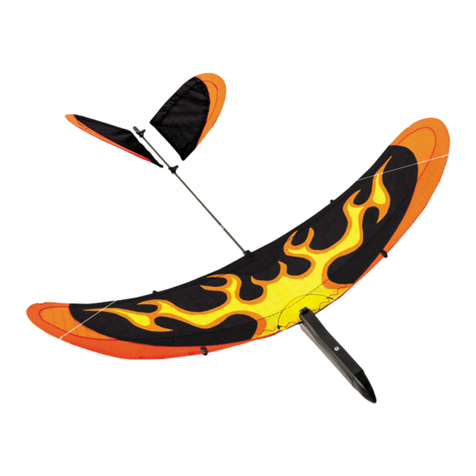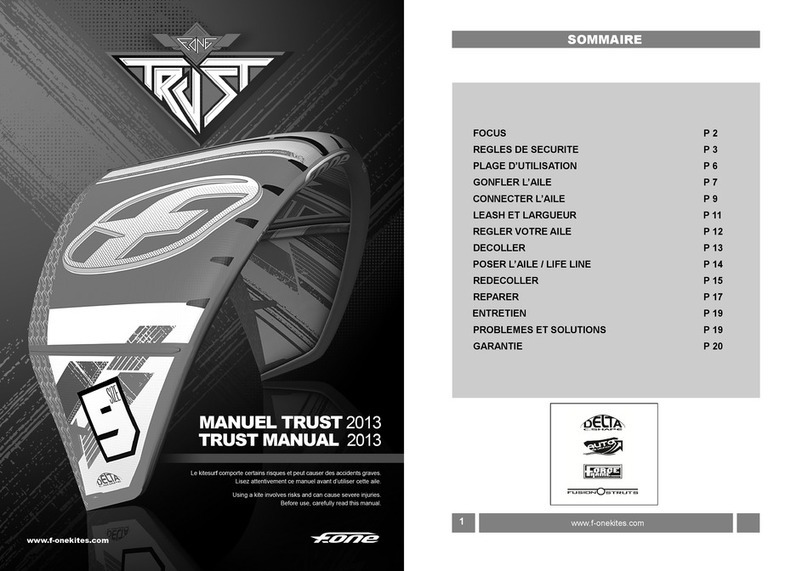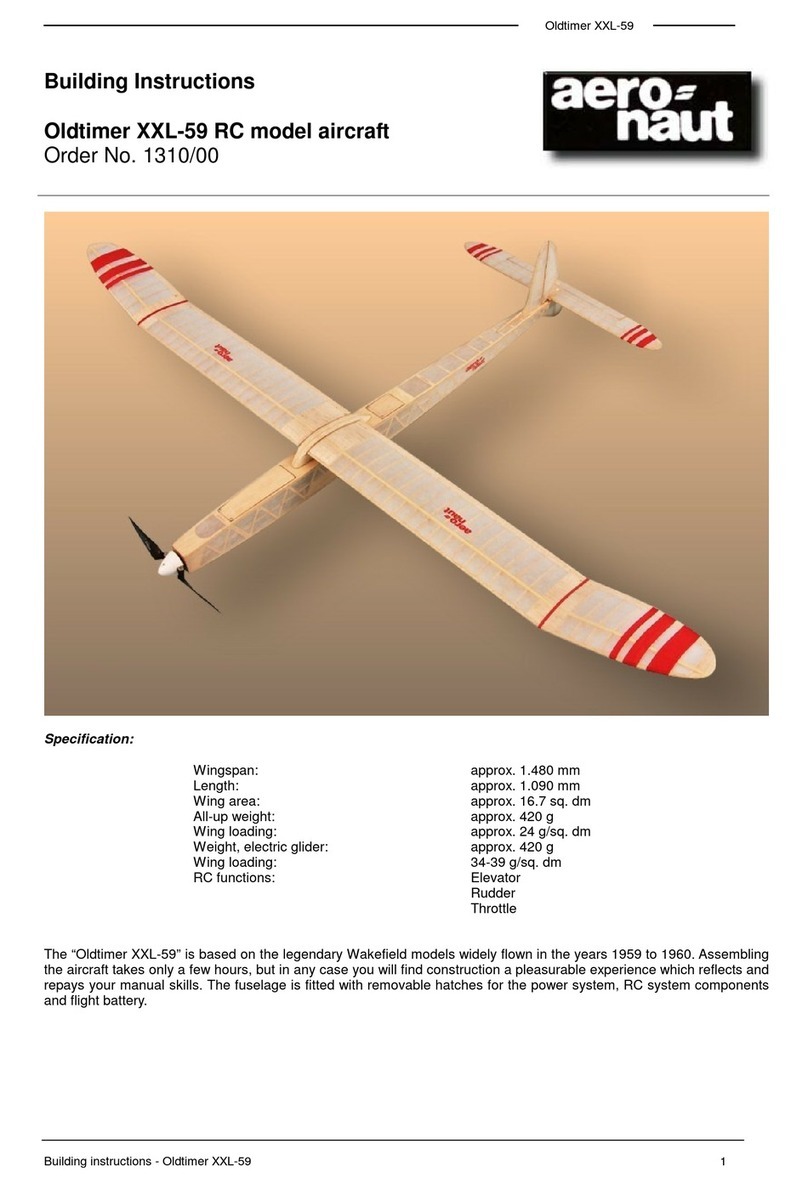moyes Gecko User manual

Moyes Delta Gliders Pty. Ltd.
Version 3
Gecko
Owner’s manual


GECKO OWNERS MANUAL
Version 3 3
CONTENTS
Amendments.........................................................................................4
Document Format.................................................................................4
Introduction...........................................................................................5
Assembly From Short Pack to Full Length............................................6
Set Up Procedure ...............................................................................10
Pre-Flight Check.................................................................................18
Flying the Gecko.................................................................................20
Pack Up ..............................................................................................21
Specifications......................................................................................25
Design Notes ......................................................................................26
Operating Limitations..........................................................................26
Disclaimer...........................................................................................27
General Tuning Hints..........................................................................28
Glider Care .........................................................................................30
Maintenance Schedule .......................................................................32
Checking the Stability System ............................................................33
Spare Parts Ordering..........................................................................34
Bolt Diagram.......................................................................................35
Bolts and Pins List………………………………………………………....36
Labelled Parts Pictures……………………………………………………38
Gecko Parts List……………………………………………………………41
Purchase Record................................................................................46
Maintenance Log ................................................................................46

GECKO OWNERS MANUAL
Version 3 4
AMENDMENTS
DOCUMENT FORMAT
This document is formatted for double sided printing. The odd numbered pages have a wider
margin on the left and the even number pages have it on the right to allow for binding along the
edge.
Version
Date
Changes
1
20 March 2016
Initial release
2
11 November 2016
Pictures, Pre-Flight Checklist, Flying the Gecko, Bolt Index & List,
Labelled Parts Diagrams
3
16 December 2016
Additional pictures and details on setting up the Gecko

GECKO OWNERS MANUAL
Version 3 5
Moyes Delta Gliders Pty. Ltd.
Unit 4 / 5 Clerke Place, Kurnell NSW Australia T: +61 (0)2 9668 8686 E: moyes@moyes.com.au
INTRODUCTION
Thank you for choosing the Moyes Gecko. You have chosen wisely. The Gecko incorporates the
latest in intermediate hang gliding design technology.
Since 1967, Moyes Delta Gliders have been leaders in hang glider development. We provide a
comprehensive international network to service all pilots. We work with some of the best pilots in
the world to ensure that our gliders are stringently built and tested to improve their performance,
handling, and safety.
This glider is intended for intermediate and experienced pilots who want a glider that is easy to fly
and also has the wings to make those longer and faster glides so you can achieve your personal
best in cross country flights.
The Gecko bridges the gap between beginner and topless gliders, providing a very capable glider
for either the advancing pilot or the advanced recreational pilot.
Please read this manual thoroughly, familiarise yourself with the set up and pack up procedures,
and take the time to practice these before going out to your site.
If in doubt about of any aspect of operating your Gecko, consult your manual or seek advice from
your Moyes dealer. Moyes is happy to help with advice and hints.
We wish you the very best flying,
The Moyes Team

GECKO OWNERS MANUAL
Version 3 6
ASSEMBLY FROM SHORT PACK TO FULL LENGTH
You may have received your glider “short packed”. This is when the outer leading edges have been
removed and packed in with the rest of the glider so the packed length is shorter. Normally your
Gecko will have been assembled to full length by your dealer. If your glider is already full length,
skip this section and go to the Set Up Procedures section.
All references to “top”, “bottom/under”, “left” and “right” refer to the side of the glider when set up in
flying mode.
1. Unzip the glider bag and roll the glider so that the top is up. Undo the straps and extend
the sail.
Right
Left
Front
Rear
Top surface
Bottom surface
(Under surface)
Kingpost
RIGHT
LEFT
LEFT
RIGHT
LEFT
The LEFT and RIGHT sides always refer to the side when the glider is set up and ready to fly and pilot is in
the control frame. If you are unsure, identify the kingpost from the rear as a reference for orientation.
! NOTE
With standard uprights, the uprights will naturally toe-in. Hold the base bar and
the upright, twistingthe upright so the connection lines up.
Kingpost
Front
Rear
Front
Rear

GECKO OWNERS MANUAL
Version 3 7
2. Remove the rear leading edge tubes which are packed separately in the same box. Remove
the packaging.
3. Expose the leading edge/cross bar junction through the inspection zipper. Remove the
packaging from the end of the front leading edges.
4. Get the rear leading edge tubes and identify the left and right sides by the color of the
sticker. LEFT is RED, RIGHT is GREEN. Lay the leading edges on the ground in the
approximate place along the wing where they will go. The dive strut cable must be on the
top of the leading edge and the dive strut must fold towards the rear.
5. On the sail wing tip, open the zip. Take the rear leading edge and slide it inside the sail. As
you proceed, rotate the dive strut forward and hold against the leading edge so it can slide
in past the cloth rib.
LEFT
RIGHT
Rear Leading Edge Inserts
Wing tip zip –insert rear leading edge through here

GECKO OWNERS MANUAL
Version 3 8
6. Push the rear leading edge into the front leading edge. Continue to slide the back section
in until the slot locates the clevis pin in the front section. If the back section is located
properly it cannot be rotated. Make sure the rear leading edge is pushed all the way in.
7. At the wing tip, the sail is held in place by a sail tab and a clevis pin that fits through the
leading edge. The sail tab goes to the bottom of the leading edge. Insert the pin through the
grommet and into the bottom hole of the leading edge at an angle. Straighten the clevis pin
while sliding the sail tab towards the leading edge. Ensure the sail tab is not twisted and is
on the bottom of the leading edge. It must not be on the top! Secure pin with safety ring.
Sail Tab (straight, not twisted)
Grommet
Clevis pin
slots
slot meets clevis pin inside

GECKO OWNERS MANUAL
Version 3 9
8. Close the zippers at the wing tip and leading edge
mid section.The long zipper for the dive strut pocket
must be left OPEN.
Verify the sail tabs are on properly. Check again after the glider has been set up.
CHECK
!
The proper attachment of the sail
tabs are critical to safe operation!
! ALERT
Safety Pin
Don’t forget the
safety ring!

GECKO OWNERS MANUAL
Version 3 10
SET UP PROCEDURE
1. Place the glider (still in the bag) on the ground with the rear into the wind and the zipper up.
Undo the zipper.
2. Undo the ties that hold the control frame; remove padding and spread the uprights.
3. Connect the basebar to the corner brackets with the pip pins.
If the glider is fitted with aerofoil uprights and a round speed bar, note that the basebar will
have a top and bottom. When in flying mode the middle bend in the speed bar is forward
and is angled downwards slightly.
4. Remove the batten bundle and any padding.
5. Lift and roll the glider so that it is standing on the control frame.
Check that the pip pins are pushed all the way through and secure.
CHECK
!
With standard uprights, the uprights will naturally toe-in. Hold the base bar and
the upright, twisting the upright so the connection lines up.
! NOTE
It is possible for the glider bag to catch the wind when rotating onto the control frame.
The bag may be removed before rotating, however, at least one tie must be secured
to prevent the sail from catching the wind. The wind has been known for catching
gliders during set up. Don’t let it catch you off guard!
! NOTE

GECKO OWNERS MANUAL
Version 3 11
6. Attach the nose wire.
7. Manoeuvre the glider so the keel and wing tips face into the wind.
8. Remove the glider bag and any remaining straps. Take it from the nose first to avoid the
bag pulling the glider over should it be caught by a strong gust. Remove remaining ties and
padding.
9. Move to the nose of the glider. Slip the sail tab over the keel. The sail tab keeps the glider
in place and from sliding back. Failure to attach the tab will stretch the sail as it slides back.
10. Insert the nose batten. The batten may need some “feeding” through the sail by pulling the
sail forward to remove any wrinkles. The front of the batten fits over the lug on the keel.
After initial assembly you may leave the nose batten located on the lug.
It will be impossible to place the nose batten on and sail tab if you forget these
steps and continue to set up the glider.
! NOTE
LEFT

GECKO OWNERS MANUAL
Version 3 12
11. Spread the wings, taking care any wires are not snagged or kinked.
Ensure that the king post rises straight up. This prevents twisting of the keel mount bracket.
12. Move to the rear of the glider. At the keel, pull the rear pullback cable coming out of the keel
pocket. Pull it back and clip it into the catch (Bailey Block) at the rear of the keel. In strong
winds the glider can be difficult to tension. Have a helper gently raise and pull forward one
wing.
DO NOT USE EXCESSIVE FORCE WHEN TENSIONING THE GLIDER.
If excess force is encountered check:
The side wires are not twisted or kinked.
The cross bar retainer wire is not caught on the nose plate assembly.
The pullback cable or VG pulleys are not caught in the hang loop assembly.
!ALERT
Check the bottom wires are not twisted or kinked.
! CHECK

GECKO OWNERS MANUAL
Version 3 13
13. Clip the king post rear wire into the Bailey Block.
Optional: The glider has a removable rear keel section that
can be used as a prop to raise the rear of the glider. This
makes it easier to insert the battens and access the dive strut.
CAREFUL: Any breeze can cause the glider to fall off the prop
and damage the glider.
This approach is best for nil or light wind.
!NOTE

GECKO OWNERS MANUAL
Version 3 14
14. Take the battens from their bag. Familiarise yourself with the functioning of the batten flip
tips. Do not use force to release them as that will break the clasp. To release them,
squeeze the tip and lift. The batten length is adjusted by screwing the tips in and out. The
length has been adjusted at the factory and should be correct.
15. Gently insert battens 1-6, moving from the centre of the wing towards the wing tip. Use light
force when inserting the battens as this will avoid wear on the batten pockets. Red tipped
battens are for the left wing, green for the right. If the battens fail to slide in completely, first
check if it is the correct batten for the pocket. It is most likely that the batten has stopped
against the back of the leading edge and requires lifting over to the front. To do this either
flick the sail up and gently push the batten at the same time, or walk to the front and lift the
sail forward bringing the batten tips over the leading edge.
16. Get the carbon fibre tip rod. At the wing tip, open the Velcro that holds the under-surface to
the top surface. Slide the fibreglass rod through the Velcro opening and into the end of the
leading edge. Make sure the label marked on the fiberglass tip is facing upward. Ensure
that the rod is pushed hard against its stop. If you have difficulty locating the rod into the
leading edge, open the zipper at the end of the leading edge to access the rod and leading
edge hole. Close the zipper.

GECKO OWNERS MANUAL
Version 3 15
17. Fit the aluminium cup of the tip lever over the end of the tip rod and tension tip by rotating
the flat end of the tip lever inboard. For extra leverage, place your thumb through the loop
that is attached to the end of the tip lever. Make sure the tip lever is locked against the tip
rod. Close the Velcro.
18. Insert the remaining battens.
19. Secure each batten by inserting the tip into the trailing edge fold, then rotating the tip end
downwards until it locks in place. The batten lengths have been adjusted in the factory and
should not need adjusting.
Sand dunes / smooth air
Make sure the tip lever is consistent on both sides when locked. The tip lever will be
latched down slightly above or below the tip rod when locked in place.
! CHECK

GECKO OWNERS MANUAL
Version 3 16
20. At the under-surface of the glider, locate the wire-braced dive struts and place them inside
the sail below the webbing loop. Close the zipper and this will create the loop necessary to
hold the struts in place.
21. Insert the 4 under-surface battens through the small holes in the under-surface. Once fully
inserted, pull each batten back slightly to secure it within the pocket.
22. Insert the speed battens and Mylar inserts on both sides. The Mylar insert pockets are
located in the under-surface trailing edge, third panel in from the tips. The speed batten
pockets are located between battens 7 and 8. Neither need to be removed once installed.
23. Attach the nose cone.
24. At the centre of the under-surface, open the zipper and remove the padding from the hang
loop ‘dingle-dangle’. Rotate the ‘dingle-dangle’ such that it is perpendicular to the keel and
the hang loop is not tangled or twisted. Poke your head inside the double surface and
inspect the frame. Close the zipper.

GECKO OWNERS MANUAL
Version 3 17
25. Clip your harness carabiner into the hang loops. There should be no tension on the back-
up safety loop when the harness is in the flying position. Ensure that the carabiner is closed
and the hang loop is hanging straight from the keel.
Harness Adjustment
It is best to have your hang loop and harness adjusted as low as possible within the control frame
(2 –7 cm above the base bar). This lower position gives maximum stability and allows greater
control input. It also gives better glider feedback.
If you need to raise or lower your harness, change your hang loops. Do not tie knots in them. Your
Moyes dealer can supply different length hang loops.
The hang loop backup should be properly secured around the keel. The hang loop main plates are
secured to the dingle-dangle with a nut and bolt. The nut should be tight enough to expose thread,
but just loose enough to allow the hang loop plates to freely swing forward and back without friction.

GECKO OWNERS MANUAL
Version 3 18
PRE-FLIGHT CHECK
Follow the same routine every time you set up. If you are distracted, begin again. A good habit is
to touch or point to each component so the check is more than a cursory glance. Items to check
include:
Hang Loop
Crossbar
Control Frame
VG
Nose Wires
Nose Plates
Leading Edge
Wing Tips
Battens
Luff Lines
Side and Rear Wires
Keel
Sail
Nuts and Bolts
Hang loop properly secured
No knots or twists
Harness hooked in and locked
Ball centred in socket joint
No bends or dents
Upright connections properly secured with visible thread
Upright pins in place and secured by safety ring (4 total)
Basebar secured to uprights by pip pin
VG tested with stopper knot in place
VG set for launching conditions
Ring attached to Bailey block
Free of kinks and fishhooks
Plates are straight and free of cracks, bends, dents
Nose batten attached to top plate
Wires and thimbles attached and straight
Feel along leading edge for dents, bulges, bends
Visual inspection within sail for damage
Inspect side wire connection
Safety rings in place
Carbon tips properly secured
Dive struts properly seated
Zippers closed and Velcro fastened
All battens fastened
Safety rings attached
Free of kinks and fishhooks
Free of kinks and fishhooks
Wires are properly fastened around thimbles
Tensioning cable straight and shackle fastened to Bailey Block
Kingpost wire fastened to Bailey Block
Free from holes and tears
Screws tightly secured to frame at nose, keel, and wing tips
Sail tabs are straight and not twisted
Ensure all nuts and bolts are tight and secure

GECKO OWNERS MANUAL
Version 3 19
The glider is now ready to fly!
Climb into the harness making sure your legs are through the leg loops. Check harness height,
helmet, instruments, wind at launch and broader conditions.
Never detach the harness from the glider until you are packing up. Climb into
your harness AFTER it is attached to the glider. This will avoid the risk of taking
off without being attached.
! NOTE

GECKO OWNERS MANUAL
Version 3 20
FLYING THE GECKO
The Gecko is an intermediate hang glider with easy handling and outstanding performance. It
shines in the climb, exceeding in even the lightest lift. One of the features that makes the Gecko
unique is its transformation from zero to full VG. With VG on for best glide, the Gecko covers ground
efficiently.
Ground Handling and Launching
The Gecko’s launch characteristics are mellow and predictable. The tight side wires will give you
good control over “wings level” before launch. With a proper angle of attack the weight of the
glider is balanced. The glider will lift at low air speeds and responds quickly to inputs.
In Flight
The glider is trimmed to fly a little faster than stall speed so you should not need to apply much
pitch input.
The Gecko banks well in thermals and allows the pilot to conserve energy for long flights.
Towing
The Gecko can be towed by 3 point or pro tow (2 point), depending on pilot preference. When
towing, the pilot may want to use a quarter or third VG to reduce bar pressure. However, the Gecko
can be towed with zero VG as well.
Landing the Gecko
The success of any landing is linked to the accuracy and planning of the approach. Leave ample
time to plan and set up a safe landing with room for variable conditions or misjudgement.
If there is wind be ready for the wind gradient by flying a little faster.
While there is still enough airspeed left to flare, slowly increase your rate of push out bringing it to
a full UP and OUT arm extension. If the glider is gusted up or you have too much airspeed, stop
pushing (but do not pull in) until that energy has been used, then complete the flare. Never swing
your legs forward in anticipation of landing as this can lead to a nose-in.
Laying the Glider Flat
If the wind is over 16 kph (10 mph) and you wish to park the glider safely, it is best to lay the glider
flat on the ground with the nose into the wind. To do this, lift the nose cone to expose the nose
catch assembly. Whilst holding the keel so the glider can’t blow over, remove the nose wire ring
from the Bailey Block and carefully walk forward with the nose of the glider allowing the control bar
to fold back under the glider until you have lowered the wing to the ground.
For landing, we recommend zero VG in switchy conditions, and a quarter to a third in light or no
wind conditions. The Gecko offers a large, obvious flare window, making a crisp and clean flare
easy.
Table of contents
Other moyes Aircraft manuals
